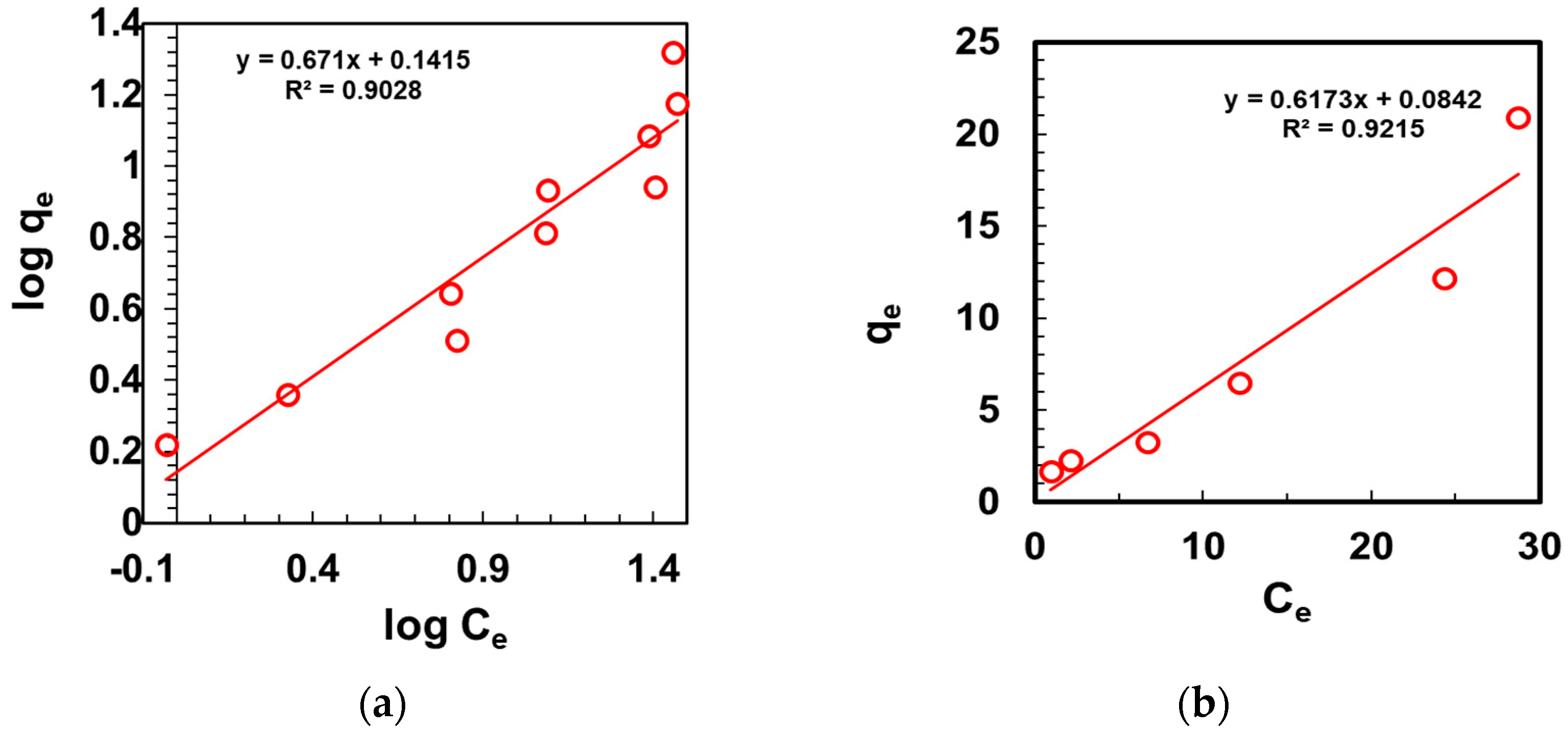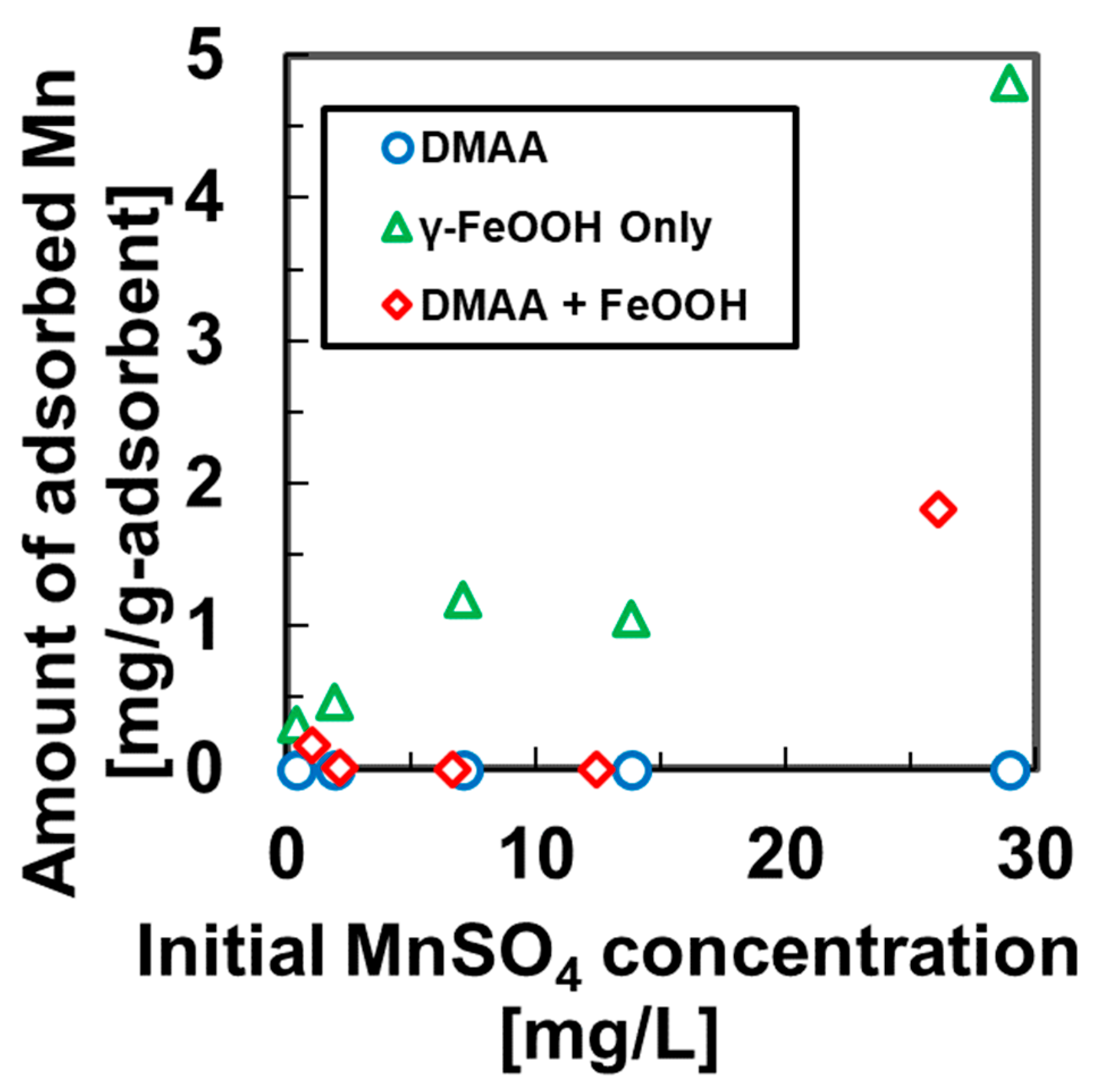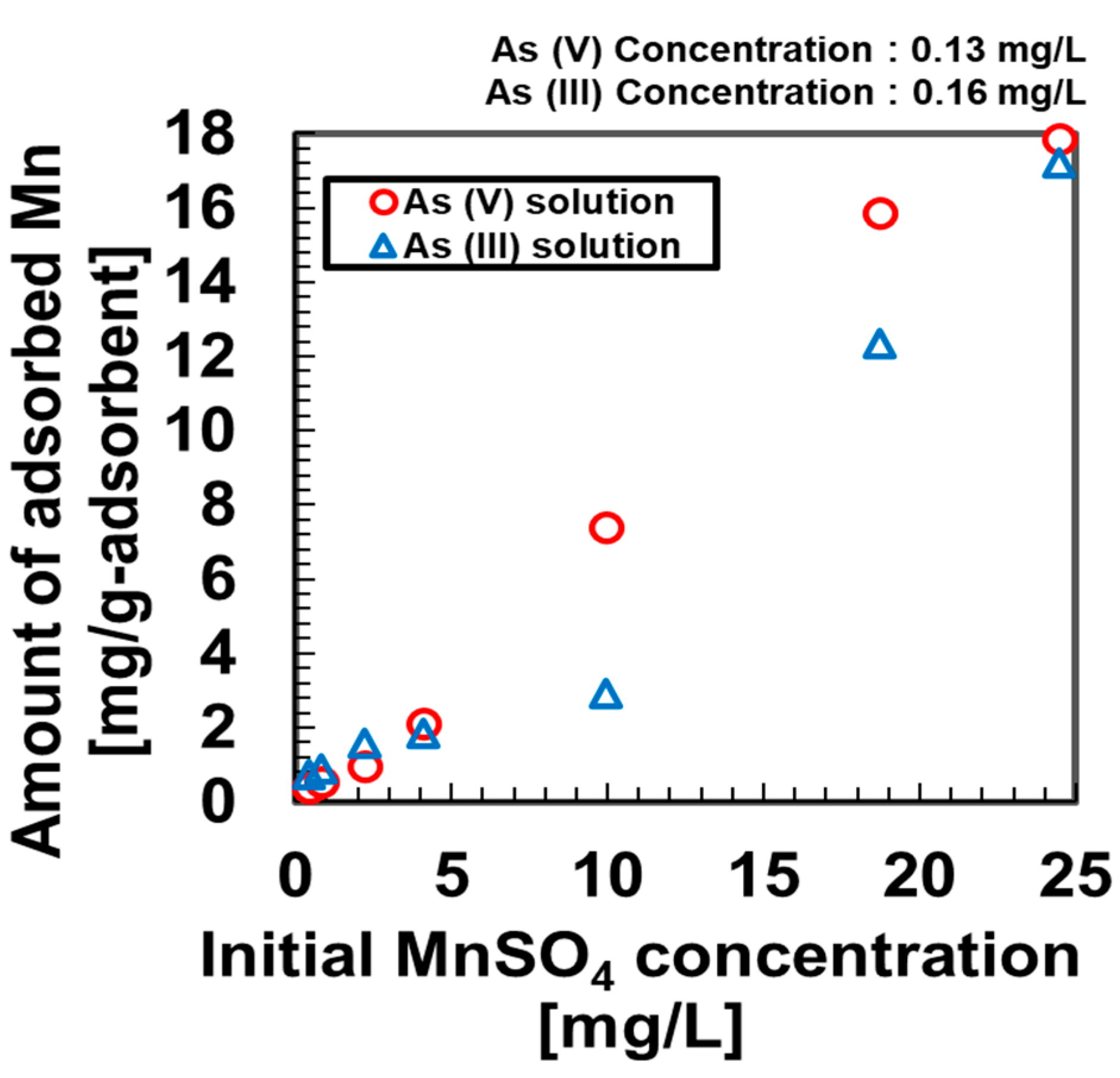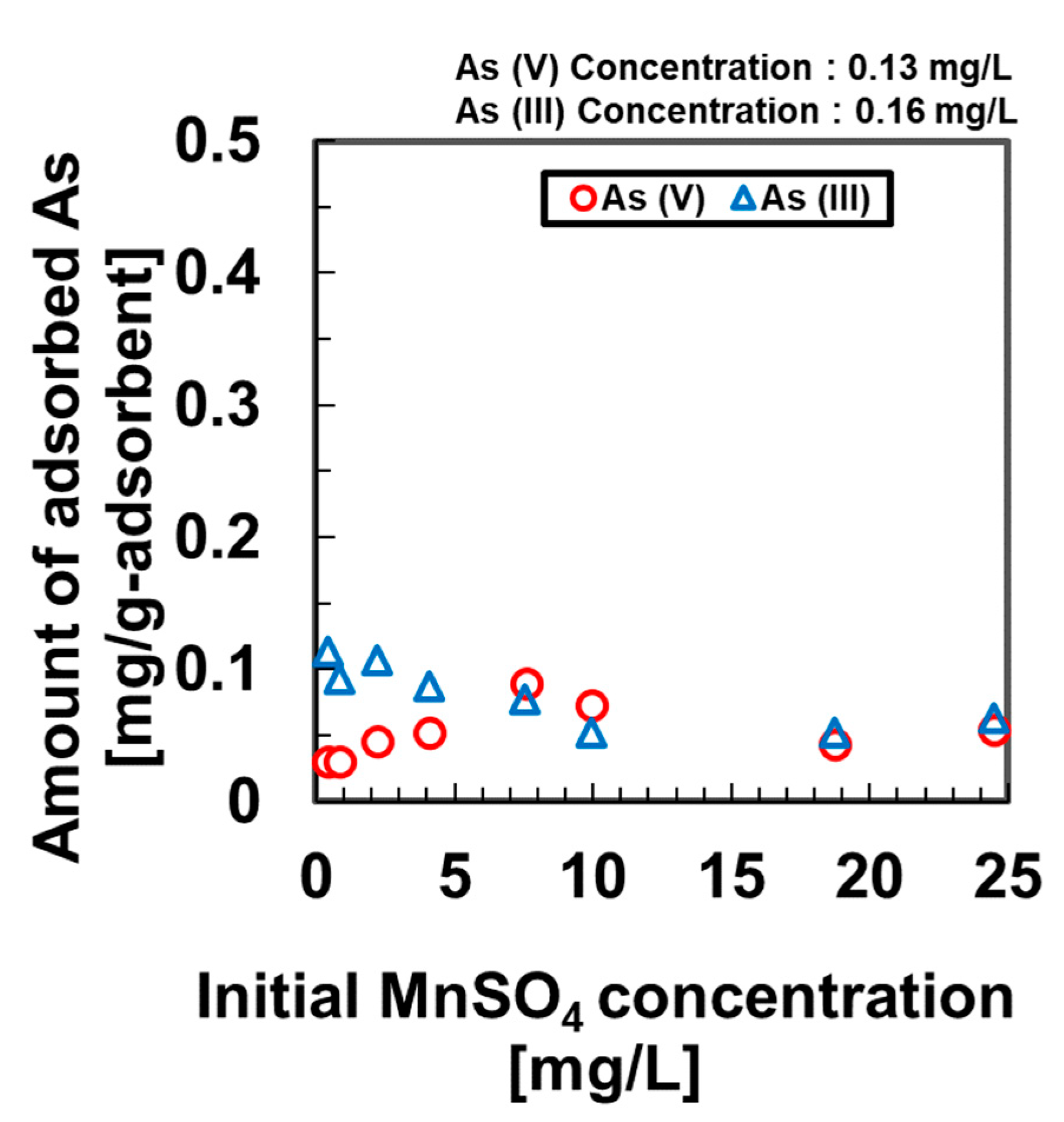Removal of Manganese Using Polymer Gel Composites †
Abstract
:1. Introduction
2. Materials and Methods
2.1. Materials
2.2. Synthesis of the Polymer Gels and Composites
2.3. Adsorption Experiment
3. Results and Discussion
3.1. Adsorption of Mn by the Cationic Gel and Cationic Gel Composite
3.2. Comparative Adsorption of Mn by Non-Ionic Gel, Non-Ionic Gel Composite, and γ-FeOOH
3.3. Simultaneous Adsorption of Mn and As
4. Conclusions
Author Contributions
Funding
Institutional Review Board Statement
Informed Consent Statement
Data Availability Statement
Acknowledgments
Conflicts of Interest
References
- Frisbie, S.H.; Ortega, R.; Maynard, D.M.; Sarkar, B. The concentrations of arsenic and other toxic elements in Bangladesh’s drinking water. Environ. Health Perspect 2002, 110, 1147–1153. [Google Scholar] [CrossRef] [PubMed]
- Sarkar, A.M.; Rahman, A.K.M.L.; Samad, A.; Bhowmick, A.C.; Islam, J.B. Surface and Ground Water Pollution in Bangladesh: A Review. Asian Rev. Environ. Earth Sci. 2019, 6, 47–69. [Google Scholar] [CrossRef]
- Verlicchi, P.; Grillini, V. Surface and Groundwater Quality in South African Area—Analysis of the Most Critical Pollutants for Drinking Purposes. Proceedings 2019, 48, 3. [Google Scholar] [CrossRef]
- Safi, S.R.; Gotoh, T.; Iizawa, T.; Nakai, S. Development and regeneration of composite of cationic gel and iron hydroxide for adsorbing arsenic from ground water. Chemosphere 2019, 217, 808–815. [Google Scholar] [CrossRef] [PubMed]
- Safi, S.R.; Gotoh, T.; Iizawa, T.; Nakai, S. Removal of Arsenic Using a Cationic Polymer Gel Impregnated with Iron Hydroxide. J. Vis. Exp. 2019, e59728. [Google Scholar] [CrossRef] [PubMed]
- Safi, S.R.; Senmoto, K.; Gotoh, T.; Iizawa, T.; Nakai, S. The effect of γ-FeOOH on enhancing arsenic adsorption from groundwater with DMAPAAQ + FeOOH gel composite. Sci. Rep. 2019, 9, 11909. [Google Scholar] [CrossRef] [PubMed]
- Langmuir Adsorption—An Overview|ScienceDirect Topics. Available online: https://www.sciencedirect.com/topics/engineering/langmuir-adsorption (accessed on 20 October 2020).
- Repo, E.; Mäkinen, M.; Rengaraj, S.; Natarajan, G.; Bhatnagar, A.; Sillanpää, M. Lepidocrocite and its heat-treated forms as effective arsenic adsorbents in aqueous medium. Chem. Eng. J. 2012, 180, 159–169. [Google Scholar] [CrossRef]
- Lin, S.; Yang, H.; Na, Z.; Lin, K. A novel biodegradable arsenic adsorbent by immobilization of iron oxyhydroxide (FeOOH) on the root powder of long-root Eichhornia crassipes. Chemosphere 2018, 192, 258–266. [Google Scholar] [CrossRef] [PubMed]
- Sung, W.; Morgan, J.J. Oxidative removal of Mn(II) from solution catalysed by the γ-FeOOH (lepidocrocite) surface. Geochim. Cosmochim. Acta 1981, 45, 2377–2383. [Google Scholar] [CrossRef]
- Deng, Y.; Li, Y.; Li, X.; Sun, Y.; Ma, J.; Lei, M.; Weng, L. Influence of calcium and phosphate on pH dependency of arsenite and arsenate adsorption to goethite. Chemosphere 2018, 199, 617–624. [Google Scholar] [CrossRef] [PubMed]
- Zhu, N.; Yan, T.; Qiao, J.; Cao, H. Adsorption of arsenic, phosphorus and chromium by bismuth impregnated biochar: Adsorption mechanism and depleted adsorbent utilization. Chemosphere 2016, 164, 32–40. [Google Scholar] [CrossRef] [PubMed]





Publisher’s Note: MDPI stays neutral with regard to jurisdictional claims in published maps and institutional affiliations. |
© 2020 by the authors. Licensee MDPI, Basel, Switzerland. This article is an open access article distributed under the terms and conditions of the Creative Commons Attribution (CC BY) license (https://creativecommons.org/licenses/by/4.0/).
Share and Cite
Safi, S.R.; Gotoh, T. Removal of Manganese Using Polymer Gel Composites. Mater. Proc. 2021, 4, 68. https://doi.org/10.3390/IOCN2020-07846
Safi SR, Gotoh T. Removal of Manganese Using Polymer Gel Composites. Materials Proceedings. 2021; 4(1):68. https://doi.org/10.3390/IOCN2020-07846
Chicago/Turabian StyleSafi, Syed Ragib, and Takehiko Gotoh. 2021. "Removal of Manganese Using Polymer Gel Composites" Materials Proceedings 4, no. 1: 68. https://doi.org/10.3390/IOCN2020-07846
APA StyleSafi, S. R., & Gotoh, T. (2021). Removal of Manganese Using Polymer Gel Composites. Materials Proceedings, 4(1), 68. https://doi.org/10.3390/IOCN2020-07846





